This was published 6 years ago
Eating tapas, Spain: Six lessons every Spanish food tourist needs to know
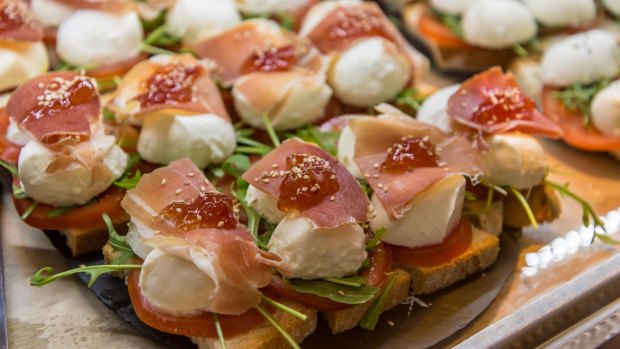
Parma ham and mozzarella.
Ask 10 Spaniards about the origins of tapas and you're likely to get 10 different replies. Tapas originated from a government edict that food had to be served with alcohol to stop people getting drunk. Tapas comes from the practice of putting a slice of bread over the top of a wine glass to prevent flies getting in. Tapas comes from the Moorish love of grazing on small morsels. Tapas comes from the 13th-century King Alfonso, an invalid able to consume only small amounts of food.
The one thing everyone does seem to agree on is that the origin of tapas is best discussed over tapas – which proves that Spain, as well as being devoted to its collective stomach, is a country with its priorities in order.
They're not exactly backing themselves into a corner with the tapas thing, either. From an unadorned plate of jamon Iberico, to chipirones (fried baby squid), the Catalan pan con tomate (tomato-rubbed bread), the vinegar hit of anchoas (anchovies with garlic and parsley) and the ubiquitous deep-fried fun of the croquettas, there is a universe of flavour to explore across the Iberian Peninsula, bursting with history and regionality and just plain old good times. So go forth and eat, right? Not so fast, friends. Plenty of tapas traps are lying in wait for the unschooled traveller. Stumble into these and you're at risk of becoming that party bore who bangs on about Spanish food being overrated.
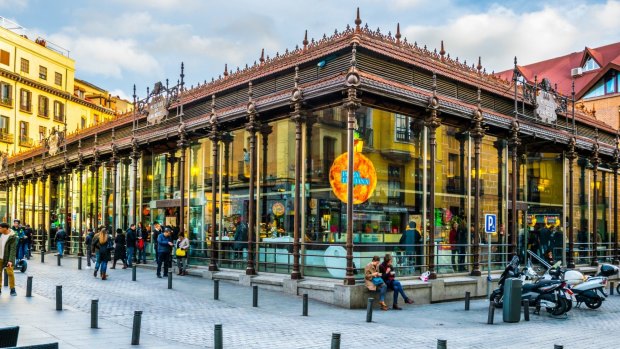
San Miguel Market (Mercado San Miguel) in Madrid's city centre.
So let's begin by digesting lesson one for the Spanish food tourist: Good tapas can be hard to find.
True, the point of tapas is not to linger. The modus operandi is to eat something, drink something, and move on to the next joint, which minimises the damage made by a poor decision. But choosing from the staggering number of restaurants and bars can send the most optimistic character into an existential crisis. This is where you need an expert on the ground – such as Margit from food tour company Devour Madrid. Margit meets us at Plaza Queen Isabel II, named after the so-called Glutton Queen ("We like to start in her shadow") and whisks us to Taberna Real (tabernareal.com), the tapas bar from central casting where a curving white marble bar is stacked high with vertiginous piles of white paper napkins.
This is the start of our tapeo – the nightly hours-long procession of tasting and tippling that whets the appetite for dinner (note: the Spanish generally manage to say this with a straight face). The tapeo might put the casual observer in mind of the Italian passeggiata, the evening promenade, although this is more ribald and involves more alcohol. At 6pm it's early by Spanish standards – embarrassingly early, but more on that later – but this is a simulation for the real deal, so Margit asks us to imagine it's 10pm, the bar is thick with people, and we're damned hungry.
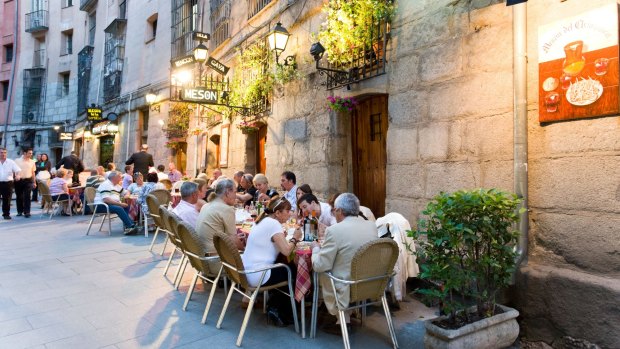
Restaurant Meson del Champinon on Calle Cava de San Miguel.Credit: Alamy
Which brings us to lesson two: Find your spot. Defend it with your life. "We tell people that when they come in they have to find their real estate," she says. "Don't be shy, because the Spanish certainly aren't. It can get a bit passive aggressive."
The tapeo typically starts with an aperitif (hello, vermouth) and small plates of pickles. At Taberna Real the wickedly green local Campo Real olives have been steeped in brine rather than vinegar for a mellow finish. There are potato chips, cut and cooked by hand (in the streets of Madrid a few old men known as freiduria can still be seen with their bucket of potatoes and knife), and thin slices of jamon Iberico de bellota, the Oscars of ham from the acorn-eating black-footed pig. Cutlery is redundant: toothpicks and fingers will suffice, hence the mountain of napkins, which also brings us to lesson three: Mess is best.
It sounds counter-intuitive, but you want to choose a place that has detritus on the floor. Toothpicks and napkins thrown around like confetti? In Spain, they're not signs of neglect and impending Health Department strife, but tokens of enjoyment.
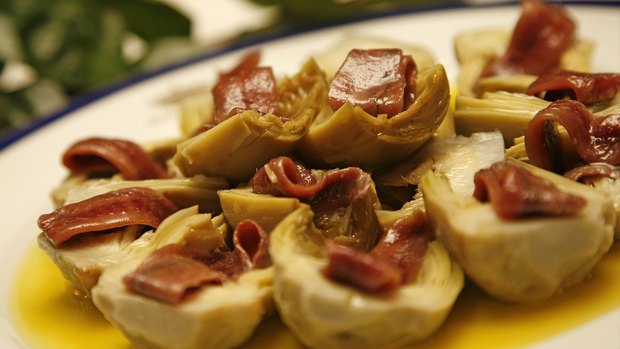
Tapas at Taberna Real.
Let's jump to lesson four: Some of the best tapas joints hide their light under a bushel. Don't even think about the restaurants ringing Plaza Mayor if you want to keep your foodie head held high. Cut through the glorious Mercado de San Miguel (mercadodesanmiguel.es) for a look at a brilliant update of the traditional marketplace, then dive into Calle Cava de San Miguel, a steep curving street lined with specialist tapas joints such as Meson de Champinon (mesondelchampinon.com), where trays of seared mushrooms seasoned with the holy trinity of Spanish flavours – garlic, parsley and olive oil – emerge from a kitchen the size of a postage stamp.
The bystander wouldn't look twice at this unprepossessing shop, open since the 1970s, but the combination of the fragrant, oily fungi and tinto de verano (a light, summery red wine – "It's our favourite terrace drink," says Margit) is unforgettable. Ditto the gambas al ajillo – known to its English-speaking friends as sizzling garlic and chilli shrimp – at La Casa del Abuelo (lacasadelabuelo.es), a short walk away in the Sol district, where five generations of the same family have stared down Franco and the rise of fast food to cement their reputation, all without even the help of newfangled creature comforts such as chairs for diners to sit upon.
There is a saying in Spain that life is what happens between meals. But – lesson five – tapas isn't a meal. It's a ritual. In a way, it's life itself. But to a hungry Australian, the sheer incomprehensibility of a country that eats lunch at 3pm, starts the tapeo about 8pm then heads to dinner at 11pm – because you will still be hungry, si? and generally pays little more than lip-service to breakfast, is the stuff of nightmares. The only way to tackle it is to get on Spanish gustatory time as fast as possible, which may involve committing heresy by having a big breakfast to get through to that Herculean lunch.
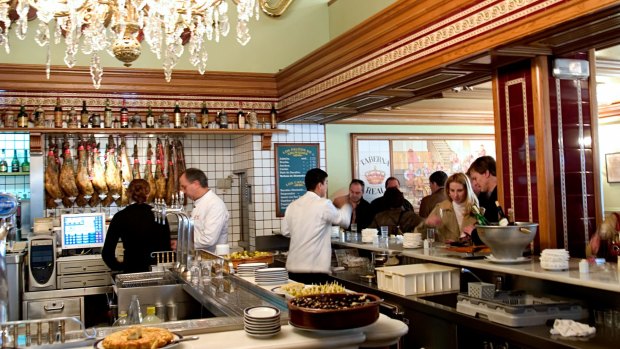
A traditional taberna at Plaza de Isabel, Madrid.Credit: Alamy
Which brings us to the sixth, and perhaps most important lesson: the afternoon siesta is invaluable.
TRIP NOTES
MORE
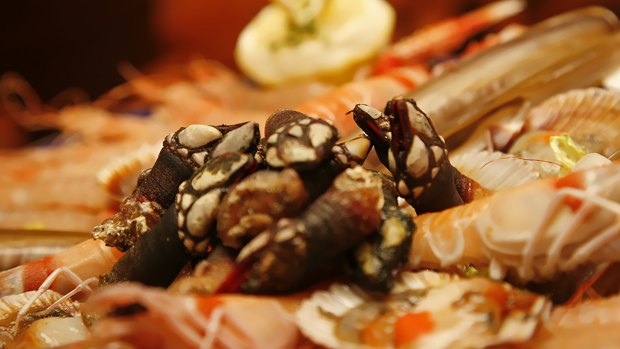
Tapas at Taberna Real.
FLY
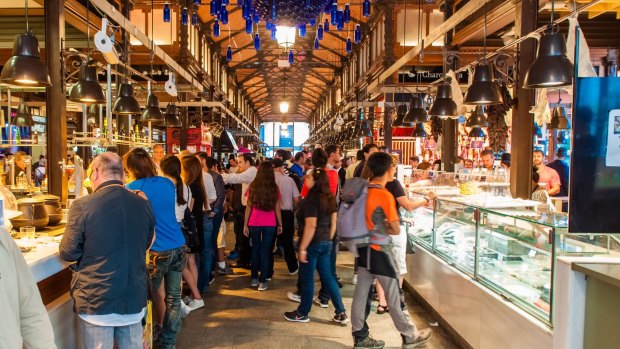
San Miguel Market in downtown Madrid.
Emirates Airlines flies from Sydney and Melbourne to Madrid, see emirates.com/au
STAY
The five-star Hotel Villa Magna (villamagna.es) in Madrid's upmarket Salamanca district is in walking distance to the Prado as well as the Platea Madrid, an art deco theatre sympathetically transformed into a complex of modern tapas bars. Rooms from €350.
TOUR
Devour Madrid runs several tours; the three-hour evening tapas and wine tasting is €85.
Larissa Dubecki was a guest of Turespana, the Spanish Institute of Tourism.
Sign up for the Traveller Deals newsletter
Get exclusive travel deals delivered straight to your inbox. Sign up now.